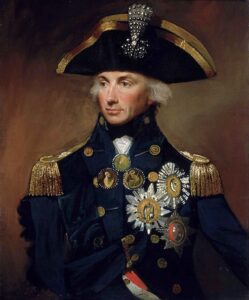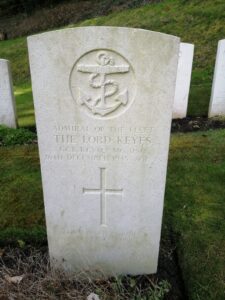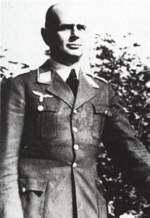Keyes, Roger John Brownlow, 1st Baron Keyes, born 04-10-1872 in Peshawar, Peshawar District,  Khyber Pakhtunkhwa, Pakistan, the second son to General Charles Patton Keyes (1822–1896)
Khyber Pakhtunkhwa, Pakistan, the second son to General Charles Patton Keyes (1822–1896)  and his wife Catherine Jessie “Kate”, born Norman Keyes (1847–1916).
and his wife Catherine Jessie “Kate”, born Norman Keyes (1847–1916).  Roger had three brothers, Lieutenant Charles Valentine Keyes (1876–1901),
Roger had three brothers, Lieutenant Charles Valentine Keyes (1876–1901),  Brigade General Sir Terence Humphrey Keyes (1877–1939) and Adrian St.Vincent Keyes (1882–1926)
Brigade General Sir Terence Humphrey Keyes (1877–1939) and Adrian St.Vincent Keyes (1882–1926)
Roger was married to Eva Mary Salvin, born Bowlby Keyes (1882- 1973)  and the couple had 3 daughters and two sons. Diana Margaret Keyes Johnson (1910–1983), Katherine Elizabeth Keyes William-Powlett
and the couple had 3 daughters and two sons. Diana Margaret Keyes Johnson (1910–1983), Katherine Elizabeth Keyes William-Powlett
(1911–1996), Elizabeth Mary Keyes (1915–1993), Lieutenant Colonel Geoffrey Charles Tasker Keyes, (1917–1941) 
 and Roger Georg Bowlby Keyes (1919–2005). The son of a soldier from a large family, he joined the Royal Navy
and Roger Georg Bowlby Keyes (1919–2005). The son of a soldier from a large family, he joined the Royal Navy  at the age of 12. In 1890, he participated in expeditions against slave trading in East Africa. After some wanderings around the world, he fought in the Boxer Rebellion
at the age of 12. In 1890, he participated in expeditions against slave trading in East Africa. After some wanderings around the world, he fought in the Boxer Rebellion  at the turn of the century. In 1905, he had to testify about the Dogger Bank incident. The Dogger Bank incident (also known as the North Sea Incident, the Russian Outrage or the Incident of Hull) occurred on the night of 21/22 October 1904, during the Russo-Japanese War, when the Baltic Fleet of the Imperial Russian Navy mistook civilian British fishing trawlers from Kingston upon Hull in the Dogger Bank area of the North Sea
at the turn of the century. In 1905, he had to testify about the Dogger Bank incident. The Dogger Bank incident (also known as the North Sea Incident, the Russian Outrage or the Incident of Hull) occurred on the night of 21/22 October 1904, during the Russo-Japanese War, when the Baltic Fleet of the Imperial Russian Navy mistook civilian British fishing trawlers from Kingston upon Hull in the Dogger Bank area of the North Sea  for Imperial Japanese Navy torpedo boats and fired on them, also firing on each other in the chaos of the melée. He led a mission to capture a flotilla of four Chinese destroyers moored to a wharf on the Peiho River. He was one of the first men to climb over the Peking walls, to break through to the besieged diplomatic legations and to free them.
for Imperial Japanese Navy torpedo boats and fired on them, also firing on each other in the chaos of the melée. He led a mission to capture a flotilla of four Chinese destroyers moored to a wharf on the Peiho River. He was one of the first men to climb over the Peking walls, to break through to the besieged diplomatic legations and to free them.
During the First World War Keyes was heavily involved in the organisation of the Dardanelles Campaign. Keyes took charge in an operation when six trawlers and a cruiser attempted to clear the Kephez minefield. Between the wars Keyes commanded the Battlecruiser Squadron, the Atlantic Fleet and then the Mediterranean Fleet before becoming Commander-in-Chief, Portsmouth. He was elected to Parliament in 1934. During the Second World War he initially became liaison officer to Leopold III, 
 King of the Belgians. Wearing full uniform in the House of Commons, he played an important role in the Norway Debate which led to the resignation of Neville Chamberlain
King of the Belgians. Wearing full uniform in the House of Commons, he played an important role in the Norway Debate which led to the resignation of Neville Chamberlain 
 as Prime Minister. He went on to be the first Director of Combined Operations and implemented plans for the training of commandos and raids on hostile coasts.
as Prime Minister. He went on to be the first Director of Combined Operations and implemented plans for the training of commandos and raids on hostile coasts.
When the Second World War broke out, Keyes was very anxious to obtain active service, but at the same time criticised the Chiefs of Staff. He reached the conclusion that the regaining of Trondheim was the key to victory in Norway. He advocated the forcing of Trondheim Fjord by battleships and the landing of a military force to recapture the city. He sought an interview with Winston Churchill, 
 the First Lord of the Admiralty; submitted an outline plan to seize the city; and offered to lead the expedition. If the Admiralty did not wish to hazard newer ships, he would take in old battleships. The chiefs of staff reached similar conclusions, with the addition of subsidiary landings north at Namsos and south at Åndalsnes. However they failed to send capital ships into Trondheim Fjord. German destroyers dominated the fjord, no airfields were seized to provide air cover and troops earmarked for the centre prong were never landed. When the troops were evacuated in early May 1940, there was shock in Britain. Parliament gathered for the Norway Debate on 7 and 8 May 1940. Making a dramatic entrance in the full uniform of an Admiral of the Fleet, including medals, Keyes defended the navy and strongly criticised the government. In his closing remarks Keyes invoked Horatio Nelson.
the First Lord of the Admiralty; submitted an outline plan to seize the city; and offered to lead the expedition. If the Admiralty did not wish to hazard newer ships, he would take in old battleships. The chiefs of staff reached similar conclusions, with the addition of subsidiary landings north at Namsos and south at Åndalsnes. However they failed to send capital ships into Trondheim Fjord. German destroyers dominated the fjord, no airfields were seized to provide air cover and troops earmarked for the centre prong were never landed. When the troops were evacuated in early May 1940, there was shock in Britain. Parliament gathered for the Norway Debate on 7 and 8 May 1940. Making a dramatic entrance in the full uniform of an Admiral of the Fleet, including medals, Keyes defended the navy and strongly criticised the government. In his closing remarks Keyes invoked Horatio Nelson. 
Harwood and his captains are typical of the Navy to-day. There are hundreds of young officers who are waiting eagerly to seize Warburton-Lee’s torch, or emulate the deeds of Vian of the Cossack. One hundred and forty years ago, Nelson said, “I am of the opinion that the boldest measures are the safest,” and that still holds good to-day.
When Germany invaded the Low Countries, as my Netherlands and neighbours Belgium in May 1940, Churchill appointed Keyes liaison officer to Leopold III, King of the Belgians. However, after Belgium surrendered to the Germans later that month, both Leopold and Keyes were attacked in the British press.[
Keyes became the first Director of Combined Operations in June 1940 and implemented plans for the training of commandos and raids on hostile coasts. He came up with bold schemes, which were considered impractical by the Chiefs of Staff, and he was removed from office in October 1941. He was elevated to the peerage as Baron Keyes, of Zeebrugge and of Dover in the County of Kent on 22-01-1943.
Death and burial ground of Keyes, Roger John Brownlow, 1st Baron Keyes.



Keyes suffered a detached retina in early 1944. He then undertook a goodwill tour of Canada, Australia and New Zealand at the request of the British government in July 1944. During his visit to the amphibious warfare ship USS Appalachian  he suffered smoke inhalation following an attack by Japanese aircraft and never fully recovered. He died at his home in Tingewick on 26-12-1945, age 73, and was buried at the Zeebrugge corner of St James’s Cemetery in Dover. Old Charlton Road, Dover CT16 1HB, United Kingdom.
he suffered smoke inhalation following an attack by Japanese aircraft and never fully recovered. He died at his home in Tingewick on 26-12-1945, age 73, and was buried at the Zeebrugge corner of St James’s Cemetery in Dover. Old Charlton Road, Dover CT16 1HB, United Kingdom.


Message(s), tips or interesting graves for the webmaster: robhopmans@outlook.com















Leave a Reply